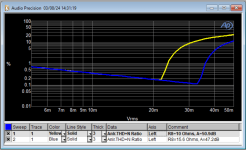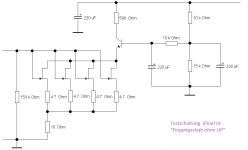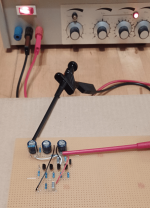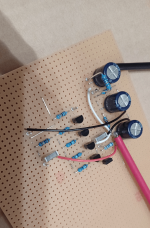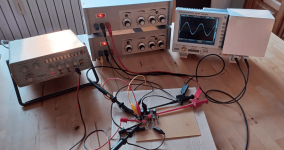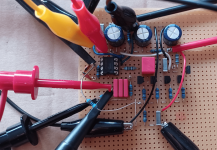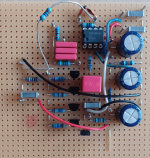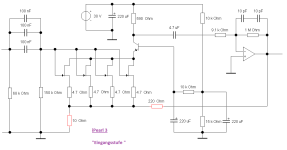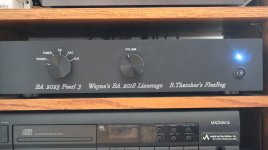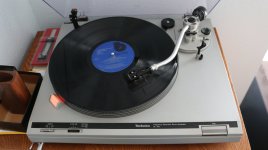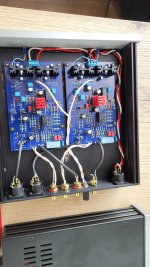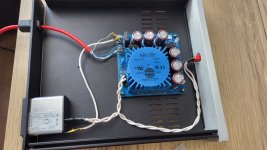You can still express wishes - if they are measurable ☕.you know what to measure?
But let's be honest, all candidates will be completely in the dark in the double-blind test.
Bye,
HBt.

We can measure difference between anonymized OPs all day long, but - on that level of overall THD, good luck corelating any measurement with sound preference
Exactly:
If there are actually audible and reproducible differences in sound, then they must be causally related to a fault or malfunction - and then we can prove this by measurement.
If there are actually audible and reproducible differences in sound, then they must be causally related to a fault or malfunction - and then we can prove this by measurement.
Now it's time for the next round,
the ZTX851 is selected and paired.
From my sample, the average HFE is 161.3, but with a standard deviation of 14.9.
So that's the way it is. But one point immediately catches my eye and that is and remains R1. Why 750 [V/A] of all things? Because 15/2 equals 7.5 and 100 times 7.5 equals 750, i.e. 7.5 /(1/100) ... 10mA!
This is an interesting approach, which results in 10mA/4 = 2.5mA per jFet and a base potential of Q5 under load conditions of 6.2V.
This allows me to quickly calculate an R3 of 25kOhm and an R2 of 28.4kOhm. This results in a divider with Riq=13.3kOhm and Uqo=7.0225V (Ik=0.528mA), i.e. R2=R3=10kOhm is a little too low - but we already know that it doesn't work that way anyway.
Now I'll build the whole thing once and then we'll take a closer look. Don't forget, the jFet sets the current.
It's so exciting,
HBt.
the ZTX851 is selected and paired.
From my sample, the average HFE is 161.3, but with a standard deviation of 14.9.
So that's the way it is. But one point immediately catches my eye and that is and remains R1. Why 750 [V/A] of all things? Because 15/2 equals 7.5 and 100 times 7.5 equals 750, i.e. 7.5 /(1/100) ... 10mA!
This is an interesting approach, which results in 10mA/4 = 2.5mA per jFet and a base potential of Q5 under load conditions of 6.2V.
This allows me to quickly calculate an R3 of 25kOhm and an R2 of 28.4kOhm. This results in a divider with Riq=13.3kOhm and Uqo=7.0225V (Ik=0.528mA), i.e. R2=R3=10kOhm is a little too low - but we already know that it doesn't work that way anyway.
Now I'll build the whole thing once and then we'll take a closer look. Don't forget, the jFet sets the current.
It's so exciting,
HBt.
Last edited:
The first prank,
without a net and double bottom:
Statically, everything is in perfect order.
Tomorrow I will flange the OP-Amplifier and then the interesting measurements and the determination of the THD will follow /begin.
I measured the potentials and voltage drops with an old HC-5010EC multimeter after about one hour of operation - I use 2SK1xxBL as jFet.
Any questions?!
HBt.
without a net and double bottom:
Statically, everything is in perfect order.
Tomorrow I will flange the OP-Amplifier and then the interesting measurements and the determination of the THD will follow /begin.
I measured the potentials and voltage drops with an old HC-5010EC multimeter after about one hour of operation - I use 2SK1xxBL as jFet.
Any questions?!
HBt.
Attachments
R8 = 10 + 5,6 = 15,6OhmMore overhead margin possible in MM mode? Yes, adding 5.6 Ohms to R8 reduces gain by 3.7dB, overhead margin increases by this amount. You can now listen to the Telarc "1812 Overture" without worry of blowing up your P3:
means that you have moved -UGS to the left, so you have changed a lot statically and dynamically.
Rather than adjust R8, I put R22||R9 at 104 ohms. It lowered gain just enough so I can run a 4mV cartridge, then use a Denon DL-110 at 1.6mV. I didnt' listen to it before making the change, but the way is sounds now is really 'REALLY" good. The bass has dynamics and is very lively. Mids are really good. The high frequencies are defined, not harsh, and cymbals, brushes and snare, kick drums are very natural and real sounding.
Listening with a MAD EAR+ headphone preamp and McIntosh MC2100 (refreshed) into Polk SDA CRS+ speakers.
Wayne - this is a home run! Thank you for sharing the design.
Listening with a MAD EAR+ headphone preamp and McIntosh MC2100 (refreshed) into Polk SDA CRS+ speakers.
Wayne - this is a home run! Thank you for sharing the design.
means that you have moved -UGS to the left, so you have changed a lot statically and dynamically.
Exactly, if you perform the same exercise with R22, by lowering its value, you will find that the THD% is impaired rather quickly.
By doing this, you require U1a to drive a 114 Ohm load (104R + 10R).Rather than adjust R8, I put R22||R9 at 104 ohms. It lowered gain just enough so I can run a 4mV cartridge,
Thank you jackinnj. U1 driving a lower impedance load is a real concern. It is possible that the LME49720 is able provide the current into a lower impedance than some other devices.
I don't have the test equipment to analyze the distortion but musically the Pearl3 sounds better than any phono pre I have used to date. I am running U1 bias around 4mA. Does that lower the distortion at all?
I don't have the test equipment to analyze the distortion but musically the Pearl3 sounds better than any phono pre I have used to date. I am running U1 bias around 4mA. Does that lower the distortion at all?
A feat!Exactly, if you perform the same exercise with R22, by lowering its value, you will find that the THD% is impaired rather quickly.
Let's assume the worst case and consider R22+R8 as a load, then I can easily calculate a peak current of around 7mA, which our OP must still be able to deliver undistorted at a signal frequency of 20kHz.
This would already provide us with a criterion - as a rough estimate for a loud MM system and a signal with maximum (recorded) level at the highest frequencies.
Thank God this should be unusual.
In this case I also calculate 7.0711mAp - without the following second stage of the entire EQ.By doing this, you require U1a to drive a 114 Ohm load (104R + 10R).
Complete success,
a first test fully confirms the theoretical principles.
I dared to use an LM741, I have the following fast values with a DSO RTC1002:
Gain factor = 23.16
SR = 0.66V/µsec
ua_max = 10.6Vpp
fog approx. 45kHz under full scale
No abnormalities in the FFT. The distortion spectrum follows the spectrum of the function generator 1 to 1. Incidentally, a total cucumber, but modified and revised by myself. The sine wave is not spectrally pure, but with a good-natured THD of less than 0.5% it's not too bad. Since I know its anomalies and spectrum exactly, I still like to work with this "Voltcraft FG607" from time to time.
Interim conclusion:
At first glance, an ancient op-amp seems to be quite suitable for the next round. I'm looking forward to the results using an analyzer, looking at distortion and noise.
a first test fully confirms the theoretical principles.
I dared to use an LM741, I have the following fast values with a DSO RTC1002:
Gain factor = 23.16
SR = 0.66V/µsec
ua_max = 10.6Vpp
fog approx. 45kHz under full scale
No abnormalities in the FFT. The distortion spectrum follows the spectrum of the function generator 1 to 1. Incidentally, a total cucumber, but modified and revised by myself. The sine wave is not spectrally pure, but with a good-natured THD of less than 0.5% it's not too bad. Since I know its anomalies and spectrum exactly, I still like to work with this "Voltcraft FG607" from time to time.
Interim conclusion:
At first glance, an ancient op-amp seems to be quite suitable for the next round. I'm looking forward to the results using an analyzer, looking at distortion and noise.
Attachments
idk if this is of interest to anybody but me, but it was easy enough to measure. My Pearl 3 has been on continuously for weeks and here's the voltage drops across the four 10R source resistors of the 2SK209's, plus the ground reference resistor R8. These 2SK209s were sequentially taken off the same tape reel.

Lch Rch
R4 19.7mV 18.9mV
R5 18.5mV 20.5mV
R6 20.9mV 20.9mV
R7 17.6mV 20.7mV
R8 66.7mV 70.9mV
Lch Rch
R4 19.7mV 18.9mV
R5 18.5mV 20.5mV
R6 20.9mV 20.9mV
R7 17.6mV 20.7mV
R8 66.7mV 70.9mV
I've been enjoying my Pearl 3 / BA2018 Preamp long enough. WOW! My lowly phono system consists of a Technics SL-B2 turntable - $79.00 at Jafco in 1980, a new Grado Pearl series III Gold cartridge, and the Pearl 3 integrated into a complete pre-amp. I remapped the input selections slightly and as per a suggestion, loaded the Grado with 10K and no additional capacitance. This has to be the best sound from a phono system under 5 digit $$$ I've heard. Bass is smooth, detailed, accurate. Treble is clear, detailed, no harshness. Wonderfully smooth listenable sound. Classical, Jazz, doesn't matter. It all sounds almost live.
Rest of system consists of Wayne's Linestage, a F6 Revisited (see posts in that thread), and my vintage B&W 801 Series II Matrix speakers with crossover fixes done back in the '90s.
I enjoy the analysis of the circuit, but don't forget: Its the music that matters. Listen to it.
Thanks to all of you who have provided these blessed projects to the community.
Don
Rest of system consists of Wayne's Linestage, a F6 Revisited (see posts in that thread), and my vintage B&W 801 Series II Matrix speakers with crossover fixes done back in the '90s.
I enjoy the analysis of the circuit, but don't forget: Its the music that matters. Listen to it.
Thanks to all of you who have provided these blessed projects to the community.
Don
Attachments
Last edited:
In this case I also calculate 7.0711mAp - without the following second stage of the entire EQ.
By doing this, you require U1a to drive a 114 Ohm load (104R + 10R).
I clipped out the parallel 220R for R22 and set it back to 220R + 10R. I swapped in a Denon DL-110 and with that lower output it is where I prefer the gain. I didn't notice a change in distortion on the high frequencies. Maybe it would be measurable but I didn't hear it. The LME49720 starts out at .00003% THD. If it went to near .03% THD I couldn't hear it.
Friends!
I need a fresh eye. Maybe you can spot something I missed. My P3 was amazing and dead quiet. Barely any noise and no mains hum. `Then, out of the blue, one day there is a significant amount of mains hum. Nothing was changed.
Setup:
Marantz PM-14S1 SE amp
Oppo BDP-105D player
Avid Ingenium turntable
A server connected via USB to the Oppo
Things I have checked until now:
Interconnect cables
Power cables (Oppo has a loose cable and moving it increased the noise. Replaced, the hum stayed)
Optical inspection of the inside of P3
Moved cables around (nothing, the hum is independent of how cables are laid)
I'm happy to hear any recommendations as I'm honestly baffled. Perhaps I missed something.
I need a fresh eye. Maybe you can spot something I missed. My P3 was amazing and dead quiet. Barely any noise and no mains hum. `Then, out of the blue, one day there is a significant amount of mains hum. Nothing was changed.
Setup:
Marantz PM-14S1 SE amp
Oppo BDP-105D player
Avid Ingenium turntable
A server connected via USB to the Oppo
Things I have checked until now:
Interconnect cables
Power cables (Oppo has a loose cable and moving it increased the noise. Replaced, the hum stayed)
Optical inspection of the inside of P3
Moved cables around (nothing, the hum is independent of how cables are laid)
I'm happy to hear any recommendations as I'm honestly baffled. Perhaps I missed something.
Attachments
I got great advice regarding the effect of the digital part of my equipment...
Try to turn of the usb / server
Just my 2 cents
Try to turn of the usb / server
Just my 2 cents
- Home
- Amplifiers
- Pass Labs
- Pearl 3 Burning Amp 2023
